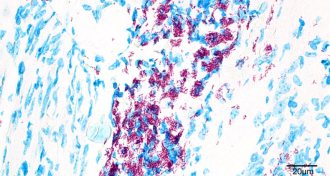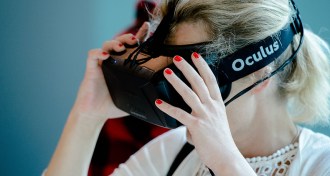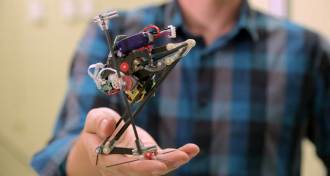News
-
 Quantum Physics
Quantum PhysicsVacuum’s quantum effect on light detected
Light can be polarized through interactions with empty space.
-
 Genetics
GeneticsEpigenetic marks may help assess toxic exposure risk — someday
Exposure to things in the environment may change chemical tags on DNA and proteins, but it’s still unclear how to use that data to assess health risks.
-
 Life
LifeEarly RNA may have used isolation strategy to defeat useless mutants
Temporary barriers help RNA escape shorter, faster-replicating parasites
-
 Ecosystems
EcosystemsLosing tropical forest might raise risks of human skin ulcers, deformed bones
Bacteria that cause Buruli ulcer in people flourish with tropical deforestation.
By Susan Milius -
 Neuroscience
NeuroscienceBrain waves show promise against Alzheimer’s protein in mice
Flickers of light induce brain waves that wash amyloid-beta out of the brain, mouse study suggests.
-
 Science & Society
Science & SocietyVirtual reality raises real risk of motion sickness
New research confirms anecdotal reports that virtual reality headsets can cause motion sickness, and may affect women more than men.
By Betsy Mason -
 Tech
TechZippy new jumping bot catches air again and again
Leaping robot can bounce from floor to wall, parkour-style, and, like a bush baby, uses a “super-crouch” to get extra oomph out of jumps.
By Meghan Rosen -
 Animals
AnimalsFirst spider superdads discovered
Male spiders first known to give up solitary life for offspring care, often as a single parent.
By Susan Milius -
 Quantum Physics
Quantum PhysicsCosmic test confirms quantum weirdness
Physicists used starlight to perform a cosmic Bell test.
-
 Astronomy
AstronomyStellar vomiting produces dark galaxies, simulations suggest
Dark galaxies might owe their existence to multiple rounds of prolific star birth and death that eject gas and stretch out their homes, new simulations suggest.
-
 Neuroscience
NeuroscienceGut microbe mix may spark Parkinson’s
Parkinson’s disease symptoms might be driven by gut microbes
-
 Physics
PhysicsDespite lack of free electrons, bismuth superconducts
Bismuth conducts electricity with no resistance at temperatures near absolute zero, despite lack of mobile electrons.